Explicit-STR_14.0_L06_MaterialModels
- 格式:doc
- 大小:3.85 MB
- 文档页数:65
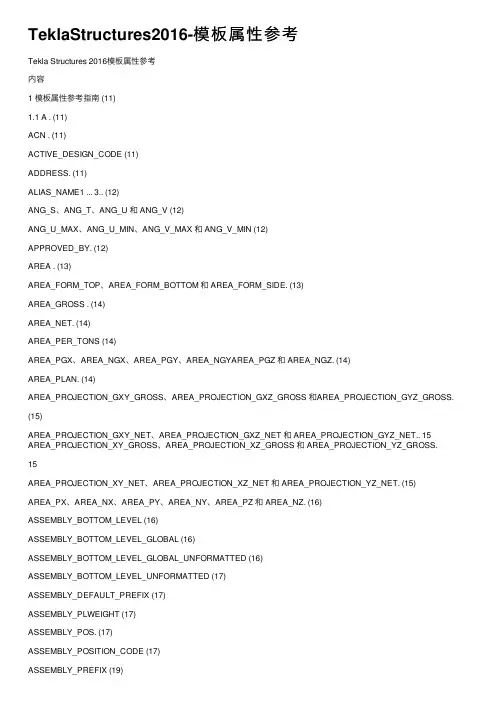
TeklaStructures2016-模板属性参考Tekla Structures 2016模板属性参考内容1 模板属性参考指南 (11)1.1 A . (11)ACN . (11)ACTIVE_DESIGN_CODE (11)ADDRESS. (11)ALIAS_NAME1 ... 3.. (12)ANG_S、ANG_T、ANG_U 和 ANG_V (12)ANG_U_MAX、ANG_U_MIN、ANG_V_MAX 和 ANG_V_MIN (12)APPROVED_BY. (12)AREA . (13)AREA_FORM_TOP、AREA_FORM_BOTTOM 和 AREA_FORM_SIDE. (13)AREA_GROSS . (14)AREA_NET. (14)AREA_PER_TONS (14)AREA_PGX、AREA_NGX、AREA_PGY、AREA_NGYAREA_PGZ 和 AREA_NGZ. (14)AREA_PLAN. (14)AREA_PROJECTION_GXY_GROSS、AREA_PROJECTION_GXZ_GROSS 和AREA_PROJECTION_GYZ_GROSS.(15)AREA_PROJECTION_GXY_NET、AREA_PROJECTION_GXZ_NET 和 AREA_PROJECTION_GYZ_NET.. 15 AREA_PROJECTION_XY_GROSS、AREA_PROJECTION_XZ_GROSS 和 AREA_PROJECTION_YZ_GROSS.15AREA_PROJECTION_XY_NET、AREA_PROJECTION_XZ_NET 和 AREA_PROJECTION_YZ_NET. (15)AREA_PX、AREA_NX、AREA_PY、AREA_NY、AREA_PZ 和 AREA_NZ. (16)ASSEMBLY_BOTTOM_LEVEL (16)ASSEMBLY_BOTTOM_LEVEL_GLOBAL (16)ASSEMBLY_BOTTOM_LEVEL_GLOBAL_UNFORMATTED (16)ASSEMBLY_BOTTOM_LEVEL_UNFORMATTED (17)ASSEMBLY_DEFAULT_PREFIX (17)ASSEMBLY_PLWEIGHT (17)ASSEMBLY_POS. (17)ASSEMBLY_POSITION_CODE (17)ASSEMBLY_PREFIX (19)ASSEMBLY_SERIAL_NUMBER (19)ASSEMBLY_START_NUMBER (19)ASSEMBLY_TOP_LEVEL (19)ASSEMBLY_TOP_LEVEL_GLOBAL (19)ASSEMBLY_TOP_LEVEL_GLOBAL_UNFORMATTED (20) ASSEMBLY_TOP_LEVEL_UNFORMATTED (20)axial1、axial2 (20)1.2 B . (20)BOLT_EDGE_DISTANCE (20)BOLT_EDGE_DISTANCE_MIN (20)BOLT_FULL_NAME (20)BOLT_MATERIAL_LENGTH (21)BOLT_NPARTS. (21)BOLT_SHORT_NAME (21)2BOTTOM_LEVEL_GLOBAL (22)BOTTOM_LEVEL_GLOBAL_UNFORMATTED (22) BOTTOM_LEVEL_UNFORMATTED (22)BOUNDING_BOX_xxx (22)BUILDER. (23)1.3 C . (23)cambering. (23)CANTILEVER. (23)CAST_UNIT_BOTTOM_LEVEL (23)CAST_UNIT_HEIGHT_ONLY_CONCRETE_PARTS (24) CAST_UNIT_HEIGHT_ONLY_PARTS (24)CAST_UNIT_HEIGHT_TOTAL (24)CAST_UNIT_LENGTH_ONLY_CONCRETE_PARTS (24) CAST_UNIT_LENGTH_ONLY_PARTS (24)CAST_UNIT_LENGTH_TOTAL (25)CAST_UNIT_POS (25)CAST_UNIT_POSITION_CODE (25)CAST_UNIT_PREFIX (25)CAST_UNIT_REBAR_WEIGHT (25)CAST_UNIT_SERIAL_NUMBER (25)CAST_UNIT_TOP_LEVEL (25)CAST_UNIT_TYPE (26)CAST_UNIT_VERTICAL_POSITION_CODE (26) CAST_UNIT_WIDTH_ONLY_CONCRETE_PARTS (26) CAST_UNIT_WIDTH_ONLY_PARTS (26)CAST_UNIT_WIDTH_TOTAL (26)CATALOG_NAME. (26)CC. (27)CC_CROSS. (27)CC_EXACT. (27)CC_EXACT_CROSS (27)CC_EXACT_LONG (27)CC_LONG. (27)CC_MAX. (27)CC_MAX_CROSS. (27)CC_MAX_LONG. (28)CC_MIN. (28)CC_MIN_CROSS. (28)CC_MIN_LONG. (28)变动. (28)CHECKED_BY. (29)CHECKED_DATE. (29)CLASS. (29)CLASS_ATTR. (29)CODE . (29)COG_X, COG_Y, COG_Z (29)comment (评注) (29)CONN_CODE_END1、CONN_CODE_END2 (30) CONNECTED_ASSEMBLIES (30)CONNECTED_PARTS (30)CONNECTION_CODE (30)CONNECTION_DSTV (30)CONNECTION_ERROR (30)3CONNECTION_RUNNING_NUMBER (31)CONTENTTYPE (31)COVER_AREA. (31)CREATED_BY. (31)CROSS_SECTION_AREA (32)CURRENT_PHASE (32)CURVED_SEGMENTS (32)CUSTOM.ELEMENT_WEIGHT (32)CUSTOM.HC_xxx (32)CUSTOM.MESH_xxx (33)CUSTOM.REBAR_SHAPE_COUPLERS (34)CUSTOM.WALL_xxx (35)1.4 D . (36)DATE . (37)DATE_APPROVED (37)DATE_CHECKED. (37)DATE_CREATE (37)DATE_END. (37)DATE_ISSUE. (37)DATE_LAST. (38)DATE_MODIFY (38)DATE_PLOT . (38)DATE_START. (38)DELIVERY. (38)DESCRIPTION. (38)DESIGNER. (39)DesignGroup. (39)DIAMETER. (39)DIAMETER_1,DIAMETER_2 (39)DIAMETER_X. (40)DIAMETER_Y. (40)DIM_A ... DIM_G、DIM_H1、DIM_H2、DIM_I、DIM_J、DIM_K1、DIM_K2、DIM_O、 DIM_R、DIM_R_ALL、DIM_TD、DIM_X、DIM_Y .. (40)DIM_A_MAX ...DIM_G_MAX、DIM_H1_MAX、DIM_H2_MAX、DIM_I_MAX、DIM_J_MAX、DIM_K1_MAX、DIM_K2_MAX、DIM_O_MAX、DIM_R_MAX、DIM_TD_MAX、DIM_X_MAX 和DIM_Y_MAX . (40)DIM_A_MIN ...DIM_G_MIN、DIM_H1_MIN、DIM_H2_MIN、DIM_I_MIN、DIM_J_MIN、DIM_K1_MIN、DIM_K2_MIN、DIM_O_MIN、DIM_R_MIN、DIM_TD_MIN、DIM_X_MIN 和DIM_Y_MIN . (41)DRAWING_USERFIELD_1 ... _8.. (41)DR_DEFAULT_HOLE_SIZE (41)DR_DEFAULT_WELD_SIZE (41)DR_PART_POS. (41)1.5 E . (41)ECCENTRICITY_X 和 ECCENTRICITY_Y (42)EDGE_FOLD、EDGE_FOLD_1 和 EDGE_FOLD_2 (42)END_X, END_Y, END_Z (42)END1_ANGLE_Z. (42)END1_ANGLE_Y. (43)END2_ANGLE_Z. (43)END2_ANGLE_Y. (43)END1_CODE, END2_CODE (43)END1_SKEW, END2_SKEW (43)41.6 F . (44)fabricator. (44)FATHER_ID. (44)FINISH. (44)FLANGE_LENGTH_B (44)FLANGE_LENGTH_U (44)FLANGE_SLOPE_RATIO (44)FLANGE_THICKNESS (45)FLANGE_THICKNESS_1 和 FLANGE_THICKNESS_2 (45)FLANGE_THICKNESS_B (45)FLANGE_THICKNESS_U (45)FLANGE_WIDTH. (45)FLANGE_WIDTH_1 和 FLANGE_WIDTH_2 (46)FLANGE_WIDTH_B (46)FLANGE_WIDTH_U (46)FOLD_ANGLE. (46)1.7 G . (46)GROUP_TYPE. (46)1.8 H . (47)HAS_CONNECTIONS (47)HAS_HOLES. (47)HEAD_DIAMETER (47)HEAD_THICKNESS (47)HEIGHT. (48)HEIGHT_1 ... 4.. (48)HIERARCHY_LEVEL (48)HISTORY. (49)HOLE.DIAMETER (49)HOLE_TOLERANCE (49)HOOK_START, HOOK_END (50)HOOK_START_ANGLE, HOOK_END_ANGLE (50) HOOK_START_LENGTH, HOOK_END_LENGTH (50) HOOK_START_RADIUS, HOOK_END_RADIUS (50) 1.9 I . (50)ID. (50)IFC_BUILDING. (50)IFC_BUILDING_STOREY (51)IFC_ENTITY. (51)IFC_SITE. (51)INFO1、INFO2 (51)INNER_DIAMETER (51)INSTALL_ACTUAL (51)INSTALL_PLAN. (52)IS_CONCEPTUAL (52)IS_FROZEN. (52)IS_ISSUED. (52)IS_ITEM. (53)IS_LOCKED. (53)IS_POLYBEAM. (54)IS_POUR_BREAK_VALID (54)5LAST_APPROVED_BY (54) LAST_CHECKED_BY (54)LAST_CREATED_BY (54)LAST_DATE_APPROVED (54) LAST_DATE_CHECKED (55) LAST_DATE_CREATE (55)LAST_DELIVERY (55)LAST_DESCRIPTION (55)LAST_INFO1. (55)LAST_INFO2. (55)LAST_MARK. (55)LAST_TEXT1...3.. (56) LENGTH. (56)LENGTH_GROSS. (56)LENGTH_MAX . (56)LENGTH_MIN . (56)LOCKED_BY. (56)LONG_HOLE_X (56)LONG_HOLE_Y (57)LOT_NUMBER. (57)LOT_NAME. (57)1.11 M . (57)MAIN_PART. (57)MAJOR_AXIS_LENGTH_1 ... 2. (57) MARK. (58)MATERIAL. (58)MATERIAL_TYPE (58)MESH_POS . (58)MINOR_AXIS_LENGTH_1 ... 2. (58) MODEL. (59)MODEL_TOTAL. (59) MODULUS_OF_ELASTICITY (59) MOMENT_OF_INERTIA_X (59)MOMENT_OF_INERTIA_Y (59)moment1、moment2 (59)MORTAR_VOLUME (59)1.12 N . (60)NAME. (60)NAME_BASE. (61)NEUTRAL_AXIS_LOCATION_ELASTIC_X (61) NEUTRAL_AXIS_LOCATION_ELASTIC_Y (61) NEUTRAL_AXIS_LOCATION_PLASTIC_X (61) NEUTRAL_AXIS_LOCATION_PLASTIC_Y (61) NORMALIZED_WARPING_CONSTANT (61) NUMBER、NUMBER#1、NUMBER #2 (62) NUMBER_IN_PHASE(X) (62)NUMBER_OF_TILE_TYPES (62)NUMBER_VISIBLE (62)1.13 O . (62)OBJECT. (62)OBJECT_DESCRIPTION (63)OBJECT_LOCKED (63)6ORIGIN_X、ORIGIN_Y、ORIGIN_Z (63) OBJECT_TYPE. (64)OWNER. (64)1.14 P . (64)PAGE. (64)PART_POS. (64)PART_PREFIX (65)PART_SERIAL_NUMBER (65)PART_START_NUMBER (65)PCS. (65)PHASE. (65)PLASTIC_MODULUS_X (65)PLASTIC_MODULUS_Y (66)PLATE_DENSITY (66)PLATE_THICKNESS (66)POISSONS_RATIO (66)POLAR_RADIUS_OF_GYRATION (67)PRELIM_MARK (67)PROFILE. (67)PROFILE_DENSITY (68)PROFILE_TYPE (69)PROFILE_WEIGHT (69)PROFILE_WEIGHT_NET (69)PROJECT_COMMENT (70)PROJECT_USERFIELD_1 ... 8. (70)1.15 R . (70)RADIUS. (70)RADIUS_OF_GYRATION_X (70)RADIUS_OF_GYRATION_Y (70)REBAR_MESH_LEFT_OVERHANG_CROSS (71) REBAR_MESH_LEFT_OVERHANG_LONG (71) REBAR_MESH_RIGHT_OVERHANG_CROSS (71) REBAR_MESH_RIGHT_OVERHANG_LONG (71) REBAR_POS . (71)REFERENCE_ASSEMBLY (71)REFERENCE_MODEL (73)REFERENCE_MODEL_OBJECT (73)ROUNDING_RADIUS, ROUNDING_RADIUS_1 ... 2. (74) ROW_IN_PAGE. (74)1.16 S . (74)SCALE1...5. .. (74)SCHED_FAB_DATE (74)SCREW_HOLE_DIAMETER_X (74)SCREW_HOLE_DIAMETER_Y (75)SECTION_MODULUS_X 和 SECTION_MODULUS_Y (75) SHAPE. (75)SHAPE_INTERNAL (75)SHEAR_CENTER_LOCATION (75)shear1、shear2 (75)SHOPSTATUS. (76)SIMILAR_TO_MAIN_PART (76)SITE_WORKSHOP (76)7SIZE. (76)SORT_OF_E_x_Cw_PER_G_x_J (76) SUPPLEMENT_PART_WEIGHT (77)START_X. (77)START_Y . (77)START_Z . (77)STATICAL_MOMENT_Qf (77)STATICAL_MOMENT_Qw (77)STIFFENER_DIMENSION (78)STIFFENER_DIMENSION_1 ... 3 (78)STRAND_DEBONDED_STRANDS_1...5.. (78) STRAND_DEBOND_LEN_FROM_END_1...5.. (78) STRAND_DEBOND_LEN_FROM_START_1...5. (79) STRAND_DEBOND_LEN_MIDDLE_TO_END_1...5. (79) STRAND_DEBOND_LEN_MIDDLE_TO_START_1...5 (79) STRAND_N_PATTERN (79)STRAND_N_STRAND (79)STRAND_POS. (79)STRAND_PULL_FORCE (79)STRAND_UNBONDED (80)SUBTYPE. (80)SURFACING_NAME (80)1.17 T . (80)TANGENT_OF_PRINCIPAL_AXIS_ANGLE (80)TEXT1...3. . (80)THERMAL_DILATATION (81)THICKNESS. (81)THREAD_IN_MATERIAL (81)TILE_NUMBER. (81)TILE_VOLUME (81)TIME. (81)TITLE. (81)TITLE1...3. .. (81)TOP_LEVEL . (82)TOP_LEVEL_GLOBAL (82)TOP_LEVEL_GLOBAL_UNFORMATTED (82) TOP_LEVEL_UNFORMATTED (82) TORSIONAL_CONSTANT (83)TYPE. (83)TYPE1. (83)TYPE2. (83)TYPE3. (83)TYPE4. (84)1.18 U . (84)USER_PHASE. (84)USERFIELD_1 ... _8 .. (84)1.19 V . (84)VOLUME. (84)VOLUME_GROSS. (84)VOLUME_NET. (84)VOLUME_NET_ONLY_CONCRETE_PARTS (85) VOLUME_ONLY_CONCRETE_PARTS (85)1.20 W . (85)WARPING_CONSTANT (85)8WARPING_STATICAL_MOMENT (85)WEB_HEIGHT . (85)WEB_LENGTH. (85)WEB_THICKNESS (86)WEB_THICKNESS_1,WEB_THICKNESS_2 (86) WEB_WIDTH. (86)WEIGHT. (86)WEIGHT_GROSS. (87)WEIGHT_M. (87)WEIGHT_MAX . (87)WEIGHT_MIN . (87)WEIGHT_NET . (87)WEIGHT_NET_ONLY_CONCRETE_PARTS (88)WEIGHT_ONLY_CONCRETE_PARTS (88)WEIGHT_PER_UNIT_LENGTH (88)WEIGHT_TOTAL. (88)WELD_ACTUAL_LENGTH1、WELD_ACTUAL_LENGTH2 (89)WELD_ANGLE1,WELD_ANGLE2 (89)WELD_ASSEMBLYTYPE (89)WELD_DEFAULT. (89)WELD_CROSSSECTION_AREA1、WELD_CROSSSECTION_AREA2. (89) WELD_EDGE_AROUND (89)WELD_EFFECTIVE_THROAT、WELD_EFFECTIVE_THROAT2 (90)WELD_ELECTRODE_CLASSIFICATION (90)WELD_ELECTRODE_COEFFICIENT (90)WELD_ELECTRODE_STRENGTH (90)WELD_ERRORLIST (90)WELD_FATHER_CODE (91)WELD_FATHER_NUMBER (91)WELD_FILLTYPE1, WELD_FILLTYPE2 (91)WELD_FINISH1,WELD_FINISH2 (91)WELD_INCREMENT_AMOUNT1、WELD_INCREMENT_AMOUNT2. (91) WELD_INTERMITTENT_TYPE (91)WELD_LENGTH1 ... 2 (92)WELD_NDT_INSPECTION (92)WELD_NUMBER. (92)WELD_PERIOD1 ... 2 (92)WELD_POSITION (92)WELD_POSITION_X (93)WELD_POSITION_Y (93)WELD_POSITION_Z (93)WELD_PROCESS_TYPE (93)WELD_ROOT_FACE_THICKNESS、WELD_ROOT_FACE_THICKNESS2. (93) WELD_ROOT_OPENING、WELD_ROOT_OPENING2 (93)WELD_SIZE1,WELD_SIZE2 (94)WELD_SIZE_PREFIX_ABOVE (94)WELD_SIZE_PREFIX_BELOW (94)WELD_TEXT. (94)WELD_TYPE1, WELD_TYPE2 (94)WELD_VOLUME. (94)WIDTH. (94)WIDTH_1,WIDTH_2 (95)1.21 X . (95)xs_shorten. (95)2 免责声明 (96)91 模板属性参考指南您可以在图纸和报告模板中使⽤模板域。
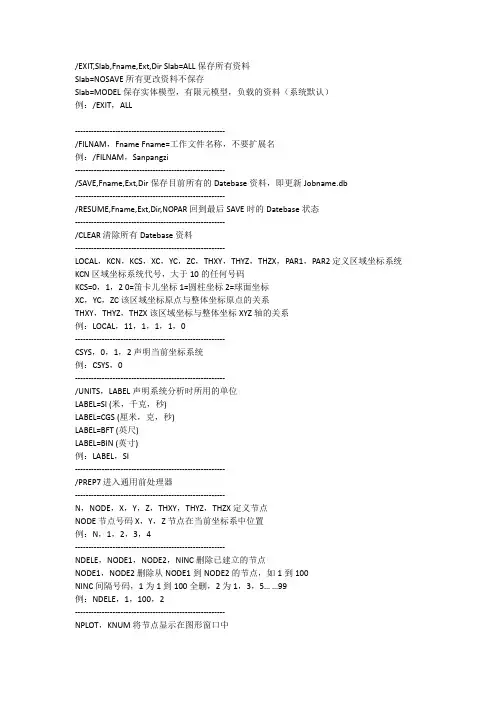
/EXIT,Slab,Fname,Ext,Dir Slab=ALL 保存所有资料Slab=NOSAVE所有更改资料不保存Slab=MODEL保存实体模型,有限元模型,负载的资料(系统默认)例:/EXIT,ALL--------------------------------------------------------/FILNAM,Fname Fname=工作文件名称,不要扩展名例:/FILNAM,Sanpangzi--------------------------------------------------------/SAVE,Fname,Ext,Dir 保存目前所有的Datebase资料,即更新Jobname.db--------------------------------------------------------/RESUME,Fname,Ext,Dir,NOPAR 回到最后SAVE时的Datebase状态--------------------------------------------------------/CLEAR 清除所有Datebase资料--------------------------------------------------------LOCAL,KCN,KCS,XC,YC,ZC,THXY,THYZ,THZX,PAR1,PAR2 定义区域坐标系统KCN 区域坐标系统代号,大于10的任何号码KCS=0,1,2 0=笛卡儿坐标 1=圆柱坐标 2=球面坐标XC,YC,ZC 该区域坐标原点与整体坐标原点的关系THXY,THYZ,THZX 该区域坐标与整体坐标XYZ轴的关系例:LOCAL,11,1,1,1,0--------------------------------------------------------CSYS,0,1,2 声明当前坐标系统例:CSYS,0--------------------------------------------------------/UNITS,LABEL 声明系统分析时所用的单位LABEL=SI (米,千克,秒)LABEL=CGS (厘米,克,秒)LABEL=BFT (英尺)LABEL=BIN (英寸)例:LABEL,SI--------------------------------------------------------/PREP7 进入通用前处理器--------------------------------------------------------N,NODE,X,Y,Z,THXY,THYZ,THZX 定义节点NODE 节点号码 X,Y,Z 节点在当前坐标系中位置例:N,1,2,3,4--------------------------------------------------------NDELE,NODE1,NODE2,NINC 删除已建立的节点NODE1,NODE2 删除从NODE1到NODE2的节点,如1到100NINC 间隔号码,1为1到100全删,2为1,3,5 (99)例:NDELE,1,100,2--------------------------------------------------------NPLOT,KNUM 将节点显示在图形窗口中KNUM=0不显示节点号码KNUM=1显示节点号码--------------------------------------------------------NLIST,NODE1,NODE2,NINC 将节点资料列在窗口中例:NLIST--------------------------------------------------------NGEN,ITIME,INC,NODE1,NODE2,NINC,DX,DY,DZ,SPACE 复制节点ITIME 复制次数,包括本身INC 复制时节点号码增量NODE1,NODE2,NINC 要复制的节点DX,DY,DZ 复制出的节点的位置改变量例:NGEN,4,5,1,5,1,1,2,3 将节点1到5复制4次,每次复制X,Y,Z方向分别移动1,2,3单位长度--------------------------------------------------------FILL,ITIME,INC,NODE1,NODE2,NINC,DX,DY,DZ,SPACE 填充节点(默认为均分填充)例:FILL,1,100 在节点1到100之间填充2,3 (99)--------------------------------------------------------ET,ITYPE,Ename,KOPT1……KOPT6,INOPR 定义元素ITYPE 元素类型编号Ename 所使用元素名称KOPT1-KOPT6 元素特性编码例:ET,1,LINK1 第1类元素为LINK1单元--------------------------------------------------------MP,Lab,MAT,C0,C1,C2,C3,C4 定义材料特性材料特性为固定值,其值为C0材料特性随温度变化,由C1-C4控制Lab 材料特性类别MAT 对应ET所定义的元素类型编号ITYPELab=EX,EY,EZ 杨氏系数Lab=DENS 密度Lab=PRXY,PRYZ,PRZX 泊松比Lab=GXY,GYZ,GZX 剪力模数例:MP,EX,1,207E9 第一类元素的杨氏系数为207E9--------------------------------------------------------R,NSET,R1……R6定义元素类型几何特性NSET 属性组别号码(系统默认值1)R1-R6 所定义元素类型几何特性值例:R,1,1E-4,2.09E-10 ,0.005--------------------------------------------------------E,I,J,K,L,M,N,O,P 定义元素连接方式I-P 定义元素节点顺序的号码例:E,1,2,5,7 四节点元素的节点顺序为1,2,5,7--------------------------------------------------------EPLOT,KNUM 将元素显示在图形窗口中ENUM=0 不显示元素ENUM=1 显示元素--------------------------------------------------------ELIST 将元素资料列在窗口中--------------------------------------------------------EDELE,IEL1,IEL2,INC 删除已建立的元素IEL1,IEL2,INC 欲删除元素的范围例:EDELE,1,10,1--------------------------------------------------------EGEN,ITIME,NINC,IEL1,IEL2,IEINC,MINC,IINC,RINC,CINC,DX,DY,DZ 复制元素ITIME 复制次数,包括本身NINC 复制时节点号码增量IEL1,IEL2,IEINC 欲复制的元素范围DX,DY,DZ 复制出的元素的位置改变量例:EGEN,6,12,1,4,1 将元素1到4复制6次--------------------------------------------------------/PNUM,Label,KEY 在图形中显示号码Label=NODE,ELEM,KP,LINE,AREA,VOLUKEY=0 不显示号码 KEY=1 显示号码例:/PNUM,ELEM,1--------------------------------------------------------/SOLU 进入解题处理器--------------------------------------------------------ANTYPE,Antype,Status 声明分析类型Antype=STATIC or 0 静态分析(系统默认)Antype=BUCKLE or 1 屈曲分析Antype=MODAL or 2 振动模态分析Antype=HARMIC or 3 调和外力动力系统分析Antype=TRANS or 4 瞬时动力系统分析例:ANTYPE,STATIC--------------------------------------------------------F,NODE,Lab,VALUE,VALUE2,NEND,NINC定义节点上的集中力NODE 节点号码Lab 外力形式Lab=FX,FY,FZ,MX,MY,MZ 结构力学Lab=HEAT 热学的热流量Lab=AMP,CHRG 电学的电流,电荷Lab=FLUX 磁学的磁通量VALUE 外力大小NODE,NEND,NINC 施力节点范围例:F,1,FY,,-200,5,1 = F,ALL,FY,-200 节点1-5 的Y方向定义集中力-200(注意FY,,表明VALUE2默认)--------------------------------------------------------FDELE,NODE,Lab,NEND,NINC 删除节点集中力例:FDELE,1,FY,5,1 = FDELE,ALL--------------------------------------------------------D,NODE,Lab,VALUE,VALUE2,NEND,NINC,Lab2,Lab3,Lab4,Lab5,Lab6 定义节点自由度的限制NODE, NEND,NINC 选取自由度约束节点的范围Lab 相对元素每一个节点受自由度约束的形式结构力学Lab=UX,UY,UZ(直线位移)Lab=ROTX,ROTY,ROTZ(旋转位移)例:D,1,UX,,,5,1 节点1到5 X方向约束D,1,UX,,,5,1,UY 节点1到5 X Y方向约束D,1,ALL,,,5,1 节点1到5 全部自由度约束注意:使用命令前要先定义元素--------------------------------------------------------DDELE,NODE,Lab,NEND,NINC 取消节点自由度约束例:DDELE,ALL--------------------------------------------------------DLIST,NODE1,NODE2,NINC 列出节点自由度约束--------------------------------------------------------DL,LINE,AREA,Lab,VALUE,VALUE2定义线自由度限制LINE 线号AREA 线所属面积例:DL,8,3,ALL 定义面积3上面线8的约束注意:同时有DLLIST,DLDELE命令--------------------------------------------------------SFBEAM,ELEM,LKEY,Lab,VALI,VALJ,VAL2I,VAL2J,IOFFST,JOFFST 定义分布力作用于梁元素的方式及大小ELEM 分布力所作用的元素编号LKEY 梁元素的4个面中分布力所在面号码Lab=PRES (表示分布压力)VALI,VALJ 在I,J点分布力的值例:SFBEAM,1,1,PRES,60,30 元素1上1号面作用分布力SFBEAM,1,1,PRES,-30,60--------------------------------------------------------SFE,ELEM,LKEY,Lab,KVAL,VAL1,VAL2,VAL3,VAL4定义分布力作用于元素上的方式及大小ELEM 分布力所作用的元素编号LKEY 分布力作用边,面的号码Lab=PRES (表示分布压力)VAL1-VAL4 分布力在元素边,面上节点的值例:SFE,4,2,PRES,,20,60元素4的第2边,面作用分布力--------------------------------------------------------SF,NLIST,Lab,VALUE,VALUE2 定义节点间分布力NLIST 分布力作用边或面上所有节点Lab=PRES例:SF,ALL,PRES,10注意:SFE适用于非均匀分布力,作用在元素的边或面上SF适用于均匀分布力,作用在节点之间--------------------------------------------------------SFLIST,NODE,Lab 显示分布力--------------------------------------------------------NSEL,Type,Item,COMP,VMIN,VMAX,VINC,KABS节点选择命令Type 选择方式Type=S 选择一组节点为ACTIVE点Type=R 在现有ACTIVE点中选出一部分作为ACTIVE点Type=A 在选择一部分节点,加入ACTIVE点中Type=U 在现有ACTIVE点中,排除某些节点Type=ALL 选择全部节点作为ACTIVE点Item =NODE 用节点号码选取┇ Item =LOC 用节点坐标选取COMP=无┇ COMP=X 以节点X坐标为准VMIN,VMAX,VINC 节点选取范围例:NSEL,S,NODE,,1,13,1选1-13中奇数点为ACTIVE点NSEL,A,NODE,,14,20,1 选14-20加入ACTIVE点--------------------------------------------------------OUTPR,Item,FREQ,Cname 分析结果是否显示于输出窗口Item=ALL 所有结果 Item=NSOL 节点自由度结果FREQ 负载的次数 FREQ=ALL 最后负载例:OUTPR,ALL,ALL注意:仅用于小程序--------------------------------------------------------SOLVE 开始解题--------------------------------------------------------/POST1 进入后处理器--------------------------------------------------------PLDISP,KUND 显示结构变形结构KUND=0 显示变形后结构形状KUND=1 显示变形前后结构形状KUND=0 显示变形前后结构形状,但仅显示外观--------------------------------------------------------PLESOL,Item,Comp 显示元素的解答Item(何种解答) Comp(Item分量)S X,Y,Z,XY,YZ,ZX 应力S 1,2,3 主应力S EQV,INT 等效应力F X,Y,Z 结构力M X,Y,Z 结构力矩例:PLESOL,S,X,Y,Z--------------------------------------------------------PLNSOL,Item,Comp 显示节点的解答Item(何种解答) Comp(Item分量)S X,Y,Z,XY,YZ,ZX 应力S 1,2,3 主应力S EQV,INT 等效应力F X,Y,Z 结构力M X,Y,Z 结构力矩U X,Y,Z,SUM 位移ROT X,Y,Z,SUM 旋转位移例:PLNSOL,S,Y PLNSOL,U,X--------------------------------------------------------PRESOL,Item,Comp 打印元素解答Item(何种解答) Comp(Item分量)S X,Y,Z,XY,YZ,ZX 应力F X,Y,Z 结构力M X,Y,Z 结构力矩例:PRESOL,S,X--------------------------------------------------------PRNSOL,Item,Comp 打印节点解答Item(何种解答) Comp(Item分量)U X,Y,Z 位移U X,Y,Z方向及总向量方向位移S COMP 应力S PRIN 主应立,等效应力例:PRNSOL,U PRNSOL,S注意:查看结果通常使用PLDISP,1 PLNSOL,U,Y…… PRNSOL,S 其中PLNSOL中Comp不能省略,PRNSOL中可以省略--------------------------------------------------------TYPE,Itype 声明建立元素时,元素形式号码(对应ET的Itype)例:ET,1,LINK1 ET,2,PLANE42TYPE,1建立LINK1元素 TYPE,2建立PLANE42元素--------------------------------------------------------REAL,NSET 声明建立元素时,元素几何参数属性编号(对应R,NSET)--------------------------------------------------------MAT,MAT 声明建立元素时,元素材料特性属性编号(对应MP,MAT)--------------------------------------------------------LSWRITE,LSNUM 多重负载资料保存至文件Jobname.S0i例:LSWRITE 自动编号,不用输入--------------------------------------------------------LSSOLVE,SLMIN,LSMX,LSINC读取所定义的多重负载并解答SLMIN,LSMX,LSINC 读取负载的范围例:LSSOLVE,1,4 获得1-4负载的解答--------------------------------------------------------DDELE,NODE,Lab,NEND,NINC 删除定义的约束条件NODE, NEND,NINC 删除约束的节点范围Lab 删除约束的节点方向例:DDELE,1,UY,5,2 删除1,3,5节点的Y向约束--------------------------------------------------------FDELE,NODE,Lab,NEND,NINC 删除定义的集中力NODE, NEND,NINC 删除集中力的范围Lab 删除外力的方向例:FDELE,1,FY,5,2 删除1,3,5节点的Y向集中力--------------------------------------------------------SFDELE,Nlist,Lab 将已定义的面载荷删除Nlist 面负载所含的节点(由NSEL选择,设Nlist=ALL)Lab=PRES (结构力学)--------------------------------------------------------SFEDELE,ELEM,LKEY,Lab 将负载从元素上删除ELEM 元素编号LKEY 负载作用边,面的号码Lab=PRES (结构力学)--------------------------------------------------------SET,Lstep,SBSTEP,FACT,KIMG,TIME,NGLE,NSET检查负载结果Lstep=负载编号例:SET,2 检查第二负载的结果 PLDISP,1……注意:此命令要在/POST1中使用--------------------------------------------------------FILE,Fname,Ext,Dir 读取分析后的结果文件例:FILE,TEST,RST--------------------------------------------------------ANTYPE,Antype,Status 声明分析类型例:ANTYPE=MODAL or 2 模态分析--------------------------------------------------------MODOPT,Method,NMODE,FREQB,FREQE,PRMODE,NUMKEY 选择模态分析方法Method=REDUC 降阶法Method=SUBSP 次空间法NMODE 欲求模态个数(降阶法小于主自由度一半)FREQB,FREQE 欲探讨振动频率范围(默认全部)PRMODE 分析后,模态结果保存到结果文件的个数例:MODOPT,SUBSP,5--------------------------------------------------------M,NODE,Lab1,NEND,NINC,Lab2。
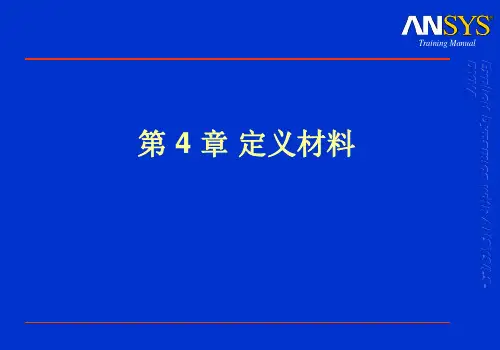
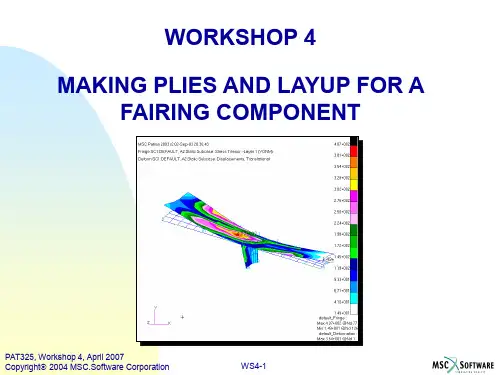
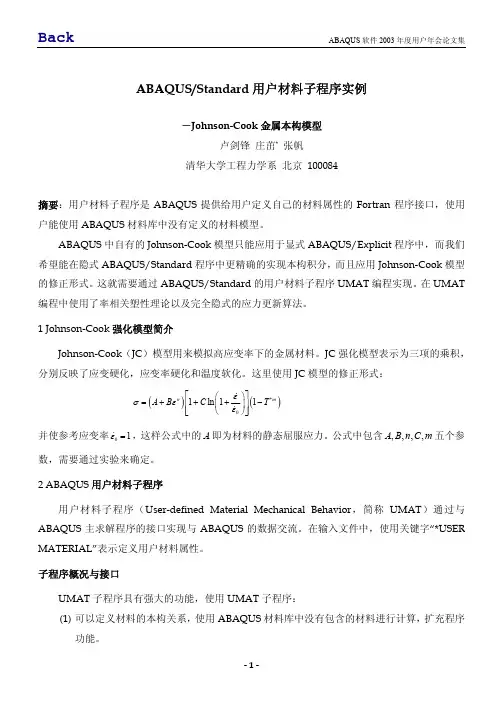
ABAQUS/Standard 用户材料子程序实例-Johnson-Cook 金属本构模型卢剑锋 庄茁* 张帆清华大学工程力学系 北京 100084摘要:用户材料子程序是ABAQUS 提供给用户定义自己的材料属性的Fortran 程序接口,使用户能使用ABAQUS 材料库中没有定义的材料模型。
ABAQUS 中自有的Johnson-Cook 模型只能应用于显式ABAQUS/Explicit 程序中,而我们希望能在隐式ABAQUS/Standard 程序中更精确的实现本构积分,而且应用Johnson-Cook 模型的修正形式。
这就需要通过ABAQUS/Standard 的用户材料子程序UMAT 编程实现。
在UMAT 编程中使用了率相关塑性理论以及完全隐式的应力更新算法。
1 Johnson-Cook 强化模型简介Johnson-Cook (JC )模型用来模拟高应变率下的金属材料。
JC 强化模型表示为三项的乘积,分别反映了应变硬化,应变率硬化和温度软化。
这里使用JC 模型的修正形式:()()*01ln 11n mA B C T εσεε=+++−&& 并使参考应变率01ε=&,这样公式中的A 即为材料的静态屈服应力。
公式中包含,,,,A B n C m 五个参数,需要通过实验来确定。
2 ABAQUS 用户材料子程序用户材料子程序(User-defined Material Mechanical Behavior ,简称UMAT )通过与ABAQUS 主求解程序的接口实现与ABAQUS 的数据交流。
在输入文件中,使用关键字“*USER MATERIAL”表示定义用户材料属性。
子程序概况与接口UMAT 子程序具有强大的功能,使用UMAT 子程序:(1) 可以定义材料的本构关系,使用ABAQUS 材料库中没有包含的材料进行计算,扩充程序功能。
(2)几乎可以用于力学行为分析的任何分析过程,几乎可以把用户材料属性赋予ABAQUS中的任何单元;(3)必须在UMAT中提供材料本构模型的雅可比(Jacobian)矩阵,即应力增量对应变增量的变化率。
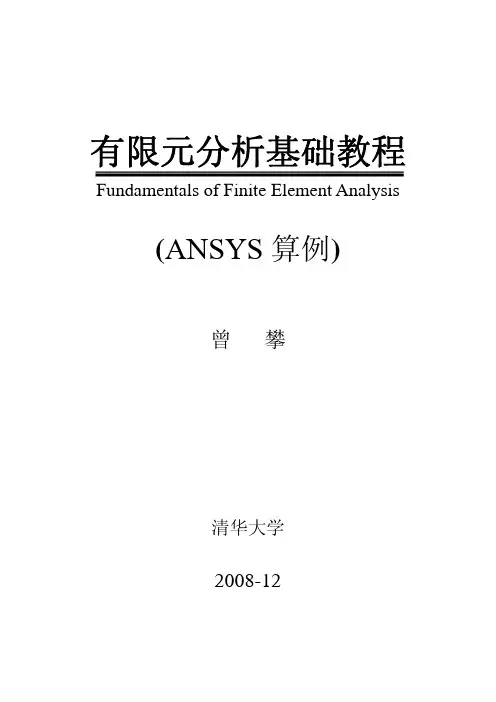
有限元分析基础教程Fundamentals of Finite Element Analysis(ANSYS算例)曾攀清华大学2008-12有限元分析基础教程曾攀有限元分析基础教程Fundamentals of Finite Element Analysis曾攀(清华大学)内容简介全教程包括两大部分,共分9章;第一部分为有限元分析基本原理,包括第1章至第5章,内容有:绪论、有限元分析过程的概要、杆梁结构分析的有限元方法、连续体结构分析的有限元方法、有限元分析中的若干问题讨论;第二部分为有限元分析的典型应用领域,包括第6章至第9章,内容有:静力结构的有限元分析、结构振动的有限元分析、传热过程的有限元分析、弹塑性材料的有限元分析。
本书以基本变量、基本方程、求解原理、单元构建、典型例题、MATLAB程序及算例、ANSYS算例等一系列规范性方式来描述有限元分析的力学原理、程序编制以及实例应用;给出的典型实例都详细提供有完整的数学推演过程以及ANSYS实现过程。
本教程的基本理论阐述简明扼要,重点突出,实例丰富,教程中的二部分内容相互衔接,也可独立使用,适合于具有大学高年级学生程度的人员作为培训教材,也适合于不同程度的读者进行自学;对于希望在MATLAB程序以及ANSYS平台进行建模分析的读者,本教程更值得参考。
本基础教程的读者对象:机械、力学、土木、水利、航空航天等专业的工程技术人员、科研工作者。
目录[[[[[[\\\\\\【ANSYS算例】3.3.7(3) 三梁平面框架结构的有限元分析 1 【ANSYS算例】4.3.2(4) 三角形单元与矩形单元的精细网格的计算比较 3 【ANSYS算例】5.3(8) 平面问题斜支座的处理 6 【ANSYS算例】6.2(2) 受均匀载荷方形板的有限元分析9 【ANSYS算例】6.4.2(1) 8万吨模锻液压机主牌坊的分析(GUI) 15 【ANSYS算例】6.4.2(2) 8万吨模锻液压机主牌坊的参数化建模与分析(命令流) 17 【ANSYS算例】7.2(1) 汽车悬挂系统的振动模态分析(GUI) 20 【ANSYS算例】7.2(2) 汽车悬挂系统的振动模态分析(命令流) 23 【ANSYS算例】7.3(1) 带有张拉的绳索的振动模态分析(GUI) 24 【ANSYS算例】7.3(2) 带有张拉的绳索的振动模态分析(命令流) 27 【ANSYS算例】7.4(1) 机翼模型的振动模态分析(GUI) 28 【ANSYS算例】7.4(2) 机翼模型的振动模态分析(命令流) 30 【ANSYS算例】8.2(1) 2D矩形板的稳态热对流的自适应分析(GUI) 31 【ANSYS算例】8.2(2) 2D矩形板的稳态热对流的自适应分析(命令流) 33 【ANSYS算例】8.3(1) 金属材料凝固过程的瞬态传热分析(GUI) 34 【ANSYS算例】8.3(2) 金属材料凝固过程的瞬态传热分析(命令流) 38 【ANSYS算例】8.4(1) 升温条件下杆件支撑结构的热应力分析(GUI) 39 【ANSYS算例】8.4(2) 升温条件下杆件支撑结构的热应力分析(命令流) 42 【ANSYS算例】9.2(2) 三杆结构塑性卸载后的残余应力计算(命令流) 45 【ANSYS算例】9.3(1) 悬臂梁在循环加载作用下的弹塑性计算(GUI) 46 【ANSYS算例】9.3(2) 悬臂梁在循环加载作用下的弹塑性计算(命令流) 49 附录 B ANSYS软件的基本操作52 B.1 基于图形界面(GUI)的交互式操作(step by step) 53 B.2 log命令流文件的调入操作(可由GUI环境下生成log文件) 56 B.3 完全的直接命令输入方式操作56 B.4 APDL参数化编程的初步操作57【ANSYS 算例】3.3.7(3) 三梁平面框架结构的有限元分析如图3-19所示的框架结构,其顶端受均布力作用,用有限元方法分析该结构的位移。
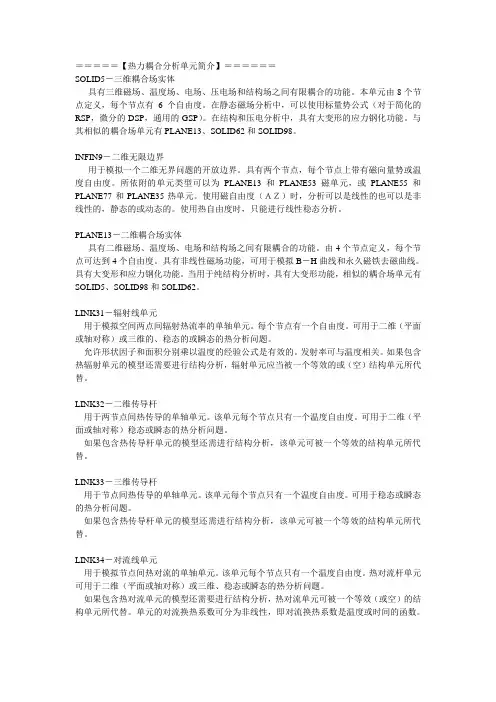
=====【热力耦合分析单元简介】======SOLID5-三维耦合场实体具有三维磁场、温度场、电场、压电场和结构场之间有限耦合的功能。
本单元由8个节点定义,每个节点有6个自由度。
在静态磁场分析中,可以使用标量势公式(对于简化的RSP,微分的DSP,通用的GSP)。
在结构和压电分析中,具有大变形的应力钢化功能。
与其相似的耦合场单元有PLANE13、SOLID62和SOLID98。
INFIN9-二维无限边界用于模拟一个二维无界问题的开放边界。
具有两个节点,每个节点上带有磁向量势或温度自由度。
所依附的单元类型可以为PLANE13和PLANE53磁单元,或PLANE55和PLANE77和PLANE35热单元。
使用磁自由度(AZ)时,分析可以是线性的也可以是非线性的,静态的或动态的。
使用热自由度时,只能进行线性稳态分析。
PLANE13-二维耦合场实体具有二维磁场、温度场、电场和结构场之间有限耦合的功能。
由4个节点定义,每个节点可达到4个自由度。
具有非线性磁场功能,可用于模拟B-H曲线和永久磁铁去磁曲线。
具有大变形和应力钢化功能。
当用于纯结构分析时,具有大变形功能,相似的耦合场单元有SOLID5、SOLID98和SOLID62。
LINK31-辐射线单元用于模拟空间两点间辐射热流率的单轴单元。
每个节点有一个自由度。
可用于二维(平面或轴对称)或三维的、稳态的或瞬态的热分析问题。
允许形状因子和面积分别乘以温度的经验公式是有效的。
发射率可与温度相关。
如果包含热辐射单元的模型还需要进行结构分析,辐射单元应当被一个等效的或(空)结构单元所代替。
LINK32-二维传导杆用于两节点间热传导的单轴单元。
该单元每个节点只有一个温度自由度。
可用于二维(平面或轴对称)稳态或瞬态的热分析问题。
如果包含热传导杆单元的模型还需进行结构分析,该单元可被一个等效的结构单元所代替。
LINK33-三维传导杆用于节点间热传导的单轴单元。
该单元每个节点只有一个温度自由度。

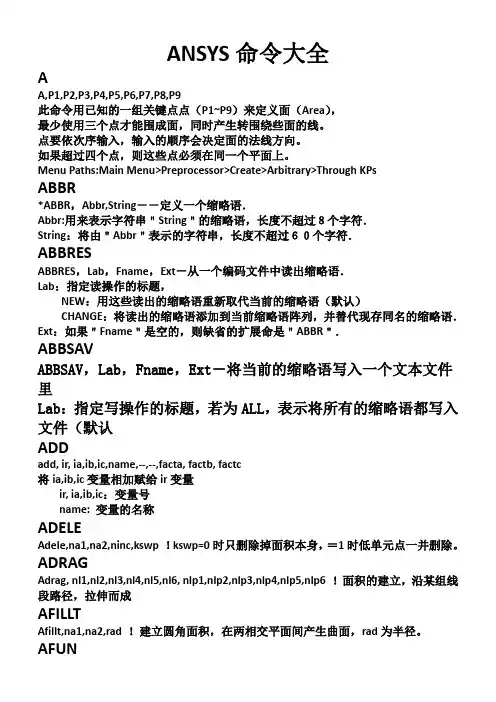
ANSYS命令大全AA,P1,P2,P3,P4,P5,P6,P7,P8,P9此命令用已知的一组关键点点(P1~P9)来定义面(Area),最少使用三个点才能围成面,同时产生转围绕些面的线。
点要依次序输入,输入的顺序会决定面的法线方向。
如果超过四个点,则这些点必须在同一个平面上。
Menu Paths:Main Menu>Preprocessor>Create>Arbitrary>Through KPsABBR*ABBR,Abbr,String--定义一个缩略语.Abbr:用来表示字符串"String"的缩略语,长度不超过8个字符.String:将由"Abbr"表示的字符串,长度不超过60个字符.ABBRESABBRES,Lab,Fname,Ext-从一个编码文件中读出缩略语.Lab:指定读操作的标题,NEW:用这些读出的缩略语重新取代当前的缩略语(默认)CHANGE:将读出的缩略语添加到当前缩略语阵列,并替代现存同名的缩略语.Ext:如果"Fname"是空的,则缺省的扩展命是"ABBR".ABBSAVABBSAV,Lab,Fname,Ext-将当前的缩略语写入一个文本文件里Lab:指定写操作的标题,若为ALL,表示将所有的缩略语都写入文件(默认ADDadd, ir, ia,ib,ic,name,--,--,facta, factb, factc将ia,ib,ic变量相加赋给ir变量ir, ia,ib,ic:变量号name: 变量的名称ADELEAdele,na1,na2,ninc,kswp !kswp=0时只删除掉面积本身,=1时低单元点一并删除。
ADRAGAdrag, nl1,nl2,nl3,nl4,nl5,nl6, nlp1,nlp2,nlp3,nlp4,nlp5,nlp6 !面积的建立,沿某组线段路径,拉伸而成AFILLTAfillt,na1,na2,rad !建立圆角面积,在两相交平面间产生曲面,rad为半径。
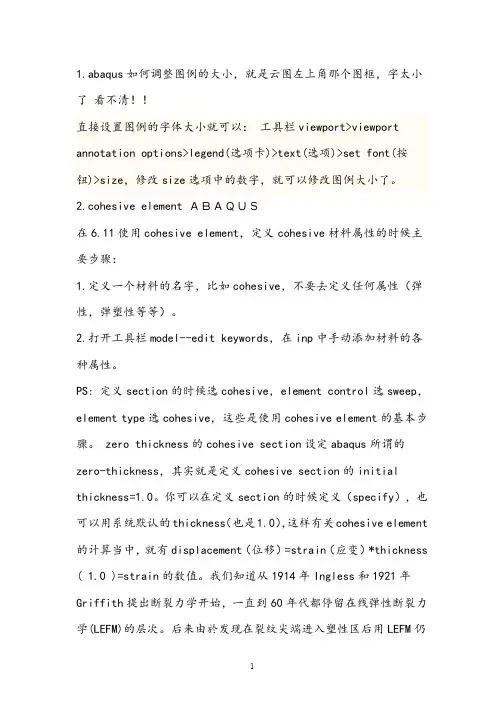
1.abaqus如何调整图例的大小,就是云图左上角那个图框,字太小了 看不清!!直接设置图例的字体大小就可以: 工具栏viewport>viewport annotation options>legend(选项卡)>text(选项)>set font(按钮)>size,修改size选项中的数字,就可以修改图例大小了。
2.cohesive element ABAQUS在6.11使用cohesive element,定义cohesive材料属性的时候主要步骤:1.定义一个材料的名字,比如cohesive,不要去定义任何属性(弹性,弹塑性等等)。
2.打开工具栏model--edit keywords,在inp中手动添加材料的各种属性。
PS: 定义section的时候选cohesive,element control选sweep,element type选cohesive,这些是使用cohesive element的基本步骤。
zero thickness的cohesive section设定abaqus所谓的zero-thickness,其实就是定义cohesive section的initial thickness=1.0。
你可以在定义section的时候定义(specify),也可以用系统默认的thickness(也是1.0),这样有关cohesive element 的计算当中,就有displacement(位移)=strain(应变)*thickness ( 1.0 )=strain的数值。
我们知道从1914年Ingless和1921年Griffith提出断裂力学开始,一直到60年代都停留在线弹性断裂力学(LEFM)的层次。
后来由於发现在裂纹尖端进入塑性区后用LEFM仍然无法解决stress singularity的问题。
1960年由Barenblatt 和Dugdale率先提出了nonlinear/plastic fracture mechnics的概念,在裂纹前端引入了plastic zone,这也就是我们现在用的 cohesive fracture mechnics的前身。
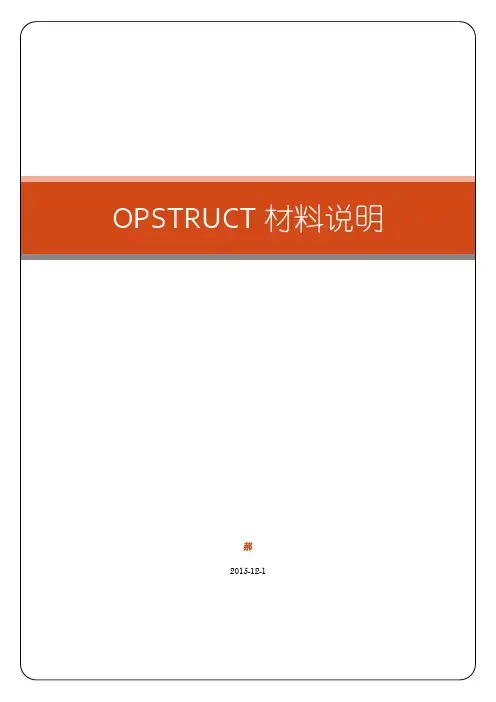
注:
5/12/1
材料说明 | 2015/12/1
Poisson’s ratio ( for uniaxial loading in 1-direction). Note that for uniaxial loading in 2-direction is related to by the relation
.
No default (Real)
注:
O P S T R U C T 材料说明 | 2015/12/1
2015/12/1
T)之间的关系:
参考应变率. 默认为0,若 DESPS < DESPS0,则无应变率作用。
5/12/1
➢ 它是在温度和应变率作用下的弹塑性法则,遵守以下法则:
➢ 若塑性应变到达最大值EPSMAX ,壳单元被删除,实体单元不被删除,但是应力被置为0; ➢ IIC 控制应变率作用。
➢ ROD 单元不考虑应变率作用
➢温度影响:
P S T R U C T 材料说明 | 2015/12/➢ 空气压力计算公式
其中,体积应变;
Φ 多孔性, P 0 是初始空气压力,
是初始体积应变; < 0 时为压缩。
➢ 若TID 为空或者0,有σy = A + B(1+ C γ), with = V/V0 - 1 = ρ/ρ0 - 1 = -μ/(1+μ)
➢ 若TID 定义了,则σy vs. is 数据来自TID ;
➢
杨氏模量计算公式为E = max(E, E 1 + E 2)
Piece-wise Linear Elastic-plastic。
drawing_setup_file!画图为Pro/ENGINEER 历程设置缺省的画图设置文件选项,不然,系统就利用缺省的画图设置文件选项值。
!该文件中的某些参数仅当具有Pro/DETAIL 许可证时才有用。
!dxf_export_mapping_file!数据交流指定DXF 输出映射文件。
可以利用文件的绝对路径或相对路径。
!ecad_board_csys_def_name!数据交流指定增添到正输入的ECAD 板的缺省坐标系名称。
假如不设置该变量,系统就提醒输入一名称。
!ecad .comp_csys_def_name!数据交流指定增添到正输入的ECAD 元件的缺省坐标系名称。
假如不设置该变量,系统就提醒输入一名称。
!ecad_mapping_file!数据交流指定用于ECAD 操作的ecad_hint.map 文件。
!ecad_other_outl_csys_def_name!数据交流为正输入的 IDF 2.0 ECAD 元件的 .OTHER_OUTLINE 截面指定缺省的坐标系名称。
!假如未设置该变量,系统会利用 ECAD 缺省名称。
!ecad_panel_csys_def_name!数据交流指定增添到所输入ECAD 面板的缺省坐标系名称。
若不设置该变量,则系统提醒需要一个名称。
!excel_analysis_directory!文件存储和检索设置Excel 剖析较量争论所用MS Excel 文件的缺省目次。
为避免泛起问题,请利用完整路径。
!extend_cvpath!数据交流扩展用于CADDS5 数据交流的CVPATH 搜刮路径。
!fem_default_solver!FEM 指定缺省的求解器。
ansys, nastran!format_setup_file!画图给每种画图花样分派一个指定的设置文件。
要为画图花样分派画图参数值,必需将画图的设置文件检索到该花样中。
dwgform.dtl!hole_parameter_file_path!特征紧固件目次,要利用完整路径名以避免泛起问题。
《史上最全的ANSYS命令流查询与解释》【1】*************************************************************************************对ansys主要命令的解释1,/PREP7 ! 加载前处理模块2,/CLEAR,NOSTART ! 清除已有的数据, 不读入启动文件的设置(不加载初始化文件)初始化文件是用于记录用户和系统选项设置的文本文件/CLEAR, START !清除系统中的所有数据,读入启动文件的设置/FILENAME, EX10.5 ! 定义工程文件名称/TITLE, EX10.5 SOLID MODEL OF AN AXIAL BEARING ! 指定标题4,F,2,FY,-1000 ! 在2号节点上施加沿着-Y方向大小为1000N的集中力6,FINISH ! 退出模块命令7,/POST1 ! 加载后处理模块8,PLDISP,2 ! 显示结构变形图,参数“2”表示用虚线绘制出原来结构的轮廓9,ETABLE,STRS,LS,1 ! 用轴向应力SAXL的编号”LS,1”定义单元表STRSETABLE, MFORX,SMISC,1 ! 以杆单元的轴力为内容, 建立单元表MFORXETABLE, SAXL, LS, 1 ! 以杆单元的轴向应力为内容, 建立单元表SAXLETABLE, EPELAXL, LEPEL, 1 ! 以杆单元的轴向应变为内容, 建立单元表EPELAXLETABLE,STRS_ST,LS,1 !以杆件的轴向应力“LS,1”为内容定义单元表STRS_STETABLE, STRS_CO, LS,1 !以杆件的轴向应力“LS,1”定义单元表STRS_COETABLE,STRSX,S,X ! 定义X方向的应力为单元表STRSXETABLE,STRSY,S,Y ! 定义Y方向的应力为单元表STRSY*GET,STRSS_ST,ELEM,STEEL_E, ETAB, STRS_ST !从单元表STRS_ST中提取STEEL_E单元的应力结果,存入变量STRSS_ST;*GET, STRSS_CO,ELEM,COPPER_E,ETAB,STRS_CO”从单元表STRS_CO中提取COPPER_E单元的应力结果,存入变量STRSS_CO10 FINISH !退出以前的模块11, /CLEAR, START ! 清除系统中的所有数据,读入启动文件的设置12 /UNITS, SI !申明采用国际单位制14 /NUMBER, 2 !只显示编号, 不使用彩色/NUMBER, 0 ! 显示编号, 并使用彩色15 /SOLU ! 进入求解模块:定义力和位移边界条件,并求解ANTYPE, STATIC ! 申明分析类型是静力分析(STA TIC或者0)OUTPR, BASIC, ALL ! 在输出结果中, 列出所有荷载步的基本计算结果OUTPR,BASIC,ALL !指定输出所有节点的基本数据OUTPR,BASIC,LAST ! 选择基本输出选项,直到最后一个荷载步OUTPR,,1 ! 输出第1个荷载步的基本计算结果OUTPR,BASIC,1 ! 选择第1荷载步的基本输出项目OUTPR,NLOAD,1 ! 指定输出第1荷载步的内容OUTRES,ALL,0 !设置将所有数据不记录到数据库。
1.将PRO/E的图形放到word文档里方法一:先在Pro/E中在线框模式(在绘图模式下也可以)下直接另存为*.CGM文件,然后在WORD中插入,此方法效果非常好,图像是矢量图形,所以可以任意缩放也不会模糊,此方法适合线条图方法二:直接使用抓图软件(如HyperSnap-DX)抓图,朔椒ㄊ屎喜噬 牡阄煌?2.POR/E渲染用自定义图片视图>颜色和外观(野火版)中3.如何将Pro/E中的零件调入3D MAX中进行渲染先将零件输出为igs文件(方法为File > Save a Copy > 出现Save a Copy对话框,在type栏中选择IGES(*. igs)在3D MAX中调入igs文件进行渲染4.渲染功能野火版的使用了CDRS相同的渲染引擎,效果好多了;渲染功能在View > Model Setup > PhotoRender改变零件中的实体或曲面的颜色功能在View > Model Setup > Color and Appearance5.关联视图view->Relate View ,点选视图,点选需要关联的Item。
6.创建打死边Wall。
Sheetmetal---Wall---Extrude---use radius,一:使用钣金件内侧边拉伸建立特征,其inside radius必需为0;二:使用钣金件外侧边拉伸建立特征,其inside radius必需为0;要画外侧轮廓线。
7.创建压边先切除缺口;Sheetmetal---Wall---Extrude---use radius在切除边上拉伸特征。
inside radius设为0。
8. 翻孔攻丝打底孔;Sheetmetal---Wall---Swept-.>Use Radius 草绘翻孔高度直线;定义Radius;Cosmetics---Thread,注意选择翻孔上来的直孔璧。
9. 修改Partial view或detail view的显示边界View-〉Modify View-〉Boundary;10. 将视图转换为与模型无关Modify view-〉Snapshot11. 伪造Drawing尺寸选尺寸-〉Proparents-〉在Text中将D改为O;写你自己的尺寸;也可以标注公差:如:@O300@++0.05@#@--0.02@# 基本尺寸300,上偏差0.05,下偏差-0.02注意:只对手工添加的尺寸有效,show的尺寸不行。
1 © 2011 ANSYS, Inc. March 8, 2012 Lecture 6 Material Models
Introduction to ANSYS Explicit STR 2 © 2011 ANSYS, Inc. March 8, 2012
Material Behavior Under Dynamic Loading In general, materials have a complex response to dynamic loading The following phenomena may need to be modelled • Non‐linear pressure response
• Strain hardening
• Strain rate hardening
• Thermal softening
• Compaction (porous materials)
• Orthotropic behavior (e.g. composites)
• Crushing damage (e.g. ceramics, glass, geological materials, concrete)
• Chemical energy deposition (e.g. explosives)
• Tensile failure
• Phase changes (solid‐liquid‐gas)
No single material model incorporates all of these effects Engineering Data offers a selection of models from which you can choose based on the material(s) present in your simulation E Modeling Provided By Engineering Data
Class ofMat al Material ElTects
Metals Elasticity I Plasticity
Isotropic Strain Hard ng
Kin natic Strain Hard dng Isotropic Strain Rate Hard dng Isotropic Th τnal Soft ng Ductile Fracture Brittle Fracture (Fra re Energy base Dynan c Failure (SpaU)
Concrete I Rock Elasticity Porous Compaction Plll ücity Strain Hard ng Strain Rate Hard ing in Compression Strain Rate Hard ing in T sion oessure Dep d t Plasticity
Lode Angle Dep d Plasticity Shear Damage I Fracture T sile Damage I Fracture
Soill Sand Elasticity Porous Compaction Plasticity oessure Dep d t Plasticity Shear Damage I Fracture T sile Damage I Fracture
Rubbers I Pol ners Elasticity I lI:nu:fJslidty
Orthotropic Orthotropic Elasticity Explosives Detonation I Expansion
3 (Q 2011 ANSYSInco March 82012 4 © 2011 ANSYS, Inc. March 8, 2012
Material Deformation Material deformation can be split into two independent parts • Volumetric Response ‐ changes in volume (pressure)
– Equation of state (EOS)
• Deviatoric Response ‐ changes in shape
– Strength model
Also, it is often necessary to specify a Failure model as materials can only sustain limited amount of stress / deformation before they break / crack / cavitate (fluids).
Change in Volume Change in
Shape 5 © 2011 ANSYS, Inc. March 8, 2012
Principal Stresses A stress state in 3D can be described by a tensor with six stress components • Components depend on the orientation of the coordinate system used.
The stress tensor itself is a physical quantity • Independent of the coordinate system used
When the coordinate system is chosen to coincide with the eigenvectors of the stress tensor, the stress tensor is represented by a diagonal matrix
where σ1, σ2 , and σ3, are the principal stresses (eigenvalues). The principal stresses may be combined to form the first, second and third stress invariants, respectively.
Because of its simplicity, working and thinking in the principal coordinate system is often used in the formulation of material models. 6 © 2011 ANSYS, Inc. March 8, 2012
Elastic Response • For linear elasticity, stresses are given by Hooke’s law :
where and G are the Lame constants (G is also known as the Shear Modulus) • The principal stresses can be decomposed into a hydrostatic and a deviatoric component :
where P is the pressure and si are the stress deviators • Then : 7 © 2011 ANSYS, Inc. March 8, 2012 f
Non‐linear Response • Many applications involve stresses considerably beyond the elastic limit and so require more complex material models
Hooke’s Law Generalized Non-Linear Response
Equation of State Strength Model Failure Model σi (max,min) = 8 © 2011 ANSYS, Inc. March 8, 2012
Models Available for Explicit Dynamics AUTODYN Equation of State Strength Model Failure Model 9 © 2011 ANSYS, Inc. March 8, 2012
Elastic Constants Shear Modulus Young’s Modulus Shear Modulus Poisson’s Ratio Shear Modulus Bulk Modulus Young’s Modulus Poisson’s Ratio Young’s Modulus Bulk Modulus Poisson’s Ratio Bulk Modulus Shear Modulus G E 2 (1+ n) 3EK 9K - E 3K (1 - 2n) 2 (1 + n) Young’s Modulus E 2G (1 + n) 9KG 3K + G 3K (1 - 2n) Poisson’s Ratio n E - 2G 2G 3K - 2G 2 (3K + G) 3K - E 6K Bulk Modulus K GE 3 (3G - E)
2G (1 + n) 3 (1 - 2n)
E 3 (1 - 2n)